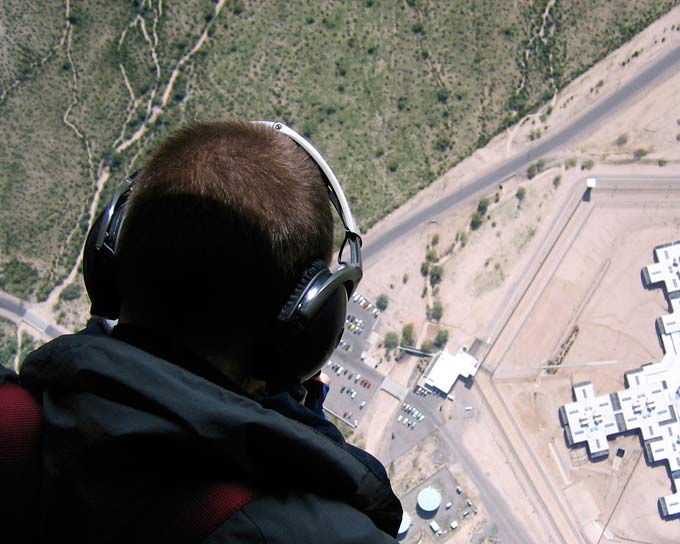
Christoph Gielen surveys Arizona’s Florence State Prison from a helicopter, 2010. Photo by Nina Gielen.
For this dispatch, Christoph Gielen shares a preview of images and text from his forthcoming “American Prison Perspectives” series. Since 2010, Gielen has used photography to confront the rapid construction of new high-tech prisons, part of a nationwide progression toward increased-security prison systems. The prison business is booming: Recognizing prisons as a growth industry, financial magazines like Barron’s have urged investors to consider buying shares of Corrections Corporation of America (CCA), the largest owner and operator of private prisons in the U.S.
With support from the Fund for Investigative Journalism, Gielen teamed up with the Canadian cultural historian Michael Prokopow to report on how Supermax prisons are designed. For his series, Gielen combines the stated objectives of prison architects with firsthand accounts of solitary confinement and the perspectives of mental health experts on the effects of isolation. In doing so, he provides a rare glimpse into the dry “science” of building maximum-security prisons.
In 2014, Gielen will launch a website entirely devoted to the “American Prison Perspectives” series. In addition to the photographs, the site will host an online forum in the hope of engaging regularly with the general public.
—
I specialize in photographic and video aerial studies of urban development, documenting its relation to land use. During a 2010 helicopter photo mission in Arizona, where I recorded sprawl patterns—the hidden geometries of suburban and exurban developments that become visible only when seen from far above the ground—I also flew over a number of prison complexes. Observing residential construction, I normally take my time to find the right position in flight, but these quick “fly-bys”—for example, over one of the Florence State Prison compounds, as seen in the shot above—were necessarily much less controlled. This airspace is technically not restricted, but it’s more or less understood that as a member of the general public, one shouldn’t come too close to any of these high-security places.
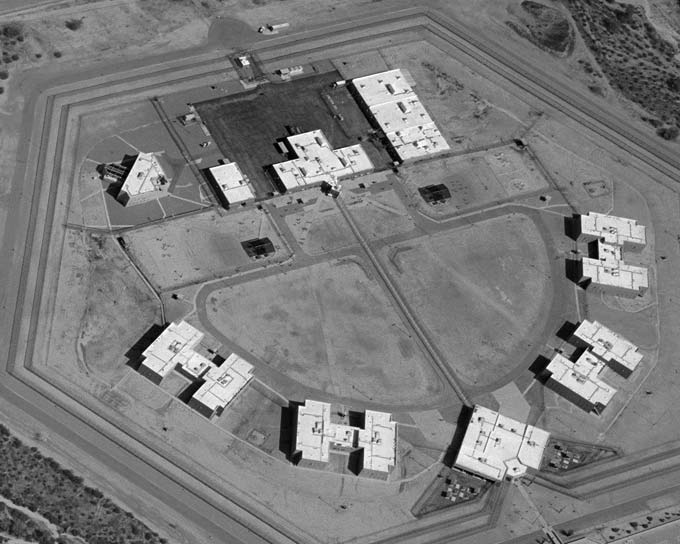
Christoph Gielen, Untitled XVI Arizona, 2010.
Initially I was interested only in the comparative planning forms of these prison structures, in contrast to regular commercial housing developments. But then I quickly became intrigued by what else these constructions might reveal, both from an aesthetic and a sociological point of view.
The above shot shows one of the six complexes that together comprise Arizona’s Florence State Prison, which includes units classified as medium to maximum security. (The unit seen here is likely a high-security facility, but clearly not maximum security.)
“Have prisons and jails become the mass housing of our time?”
Since 1980, when the U.S. prison population began to increase dramatically, Americans have been living in an era of mass incarceration, which Jeremy Travis, president of John Jay College of Criminal Justice, has called one of the “greatest social experiments of our time,” the ramifications of which have yet to be seen. Members of the Spatial Information Design Lab, a think- and action-tank at Columbia University, go so far as asking, “have prisons and jails become the mass housing of our time?”
Raising questions about a culture of incarceration is pertinent at a time when the U.S. prison population is at an unprecedented peak. The building of new prison systems appears to be a growth industry, which I address through visual representation from both new physical and ideological vantage points. With this work I want to expose the prevailing trends—documented in studies such as Sharon Shalev’s prizewinning book Supermax: Controlling Risk Through Solitary Confinement—toward building increased-security prison systems, and illustrate how prison design and architecture do in fact reflect political discourse, economic priorities, cultural sentiments and social insecurities, and how, in turn, these constructed environments also become statements about a society.
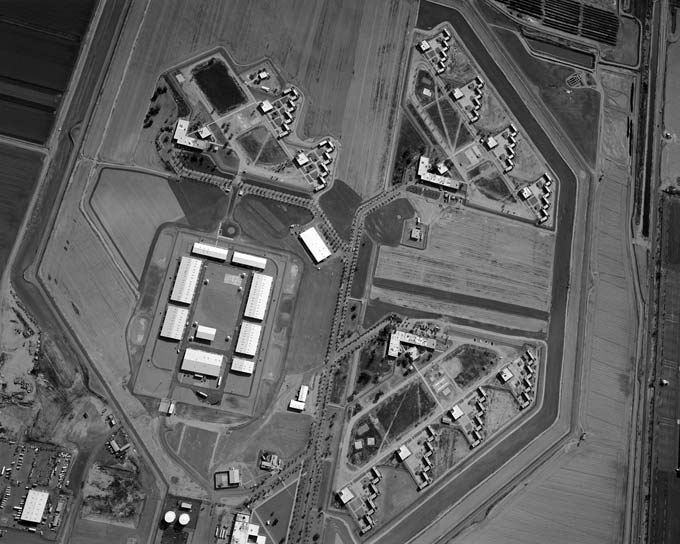
Christoph Gielen, Untitled XVIII Arizona, 2010.
This shot shows the Perryville State Prison complex. I was particularly interested in photographing this site after encountering a particularly appalling anecdote in a 2009 article in The New York Daily News, and reading more about the story through prison message boards.
A 48-year-old inmate named Marcia Powell died at this prison in an outside cage—presumably located near one of the zigzag rows of housing complexes shown above—on May 20, 2009, after four hours of exposure to 107-degree temperatures. Powell suffered first- and second-degree burns, and a core body temperature of 108 degrees when she died, an autopsy report showed later. According to a 3,000-page report released by the Arizona Department of Corrections, she pleaded to be taken back inside, but was ignored. Not permitted to use the restroom, she died in her own excrement.
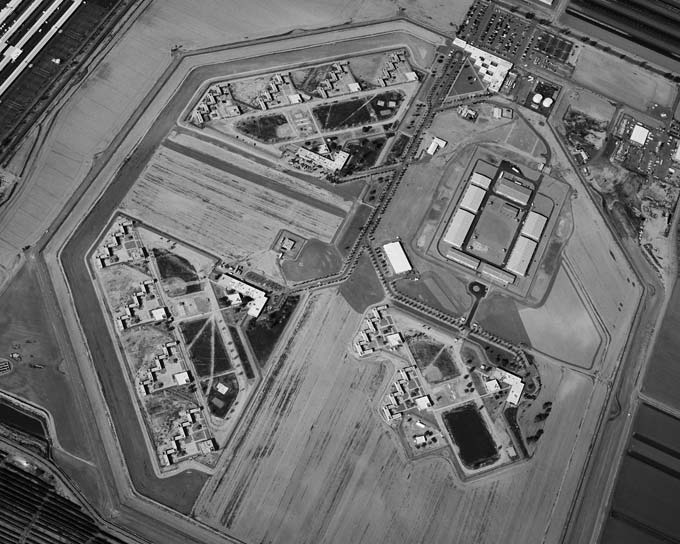
Christoph Gielen, Untitled XIII Arizona, 2010.
This image shows the Perryville State Prison from another angle. It is a medium- to high- security facility, with an inmate capacity of roughly 2,400, in eight housing units. There are two dedicated death-row facilities in the state of Arizona where prisoners await execution, divided into male and female units. The women’s death row is located in this prison compound in the “Lumley Unit.”
In “American Prison Perspectives,” I intentionally turn surveillance technology back on the surveillance apparatus of the prison itself—in a sense democratizing the use of surveillance. In other words, my method of image-capture becomes an inseparable part of its photographic content.

Christoph Gielen, Deer Crest II Suburban California, 2010.
Seen here is a small, master-planned city section in Ventura County, California, built by the Janss Investment Company in the mid-1950s. It includes about 1,000 custom home lots, a regional shopping center and an industrial park. According to June Williamson, Associate Professor of Architecture at the City College of New York, one could say that its layout represents an extension of Ebenezer Howard’s Garden City ideal (c. 1900), which was polygonal, with concentric zones to be put to various uses, and surrounded by a greenbelt. By the 1960s and 1970s, orthogonal grids were out and many residential community master planners turned to centralized circular or polygonal geometric patterns as an alternative, especially when they were building on fields that didn’t need to plug into preexisting street patterns.
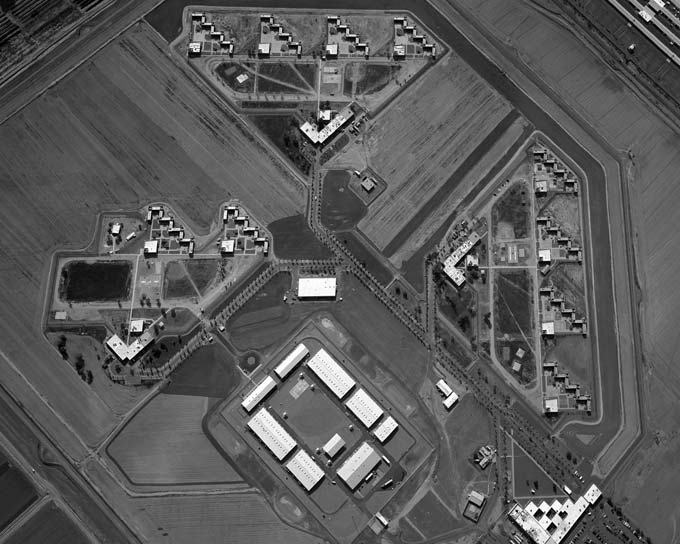
Christoph Gielen, Untitled XIV Arizona, 2010.
What connects the shot of a city section in California to these new prison perspectives is a startling recurrence of polygons, and in particular hexagons. I started noticing these prominent patterns cropping up repeatedly when I first photographed sprawl from helicopters, detecting hidden geometries in housing developments from the sky. And that really brings the notion of prisons as our new mass housing full circle.

Christoph Gielen, Deer Crest V Suburban California, 2010.
The above is one more view, from a higher altitude, of the Ventura County city section.
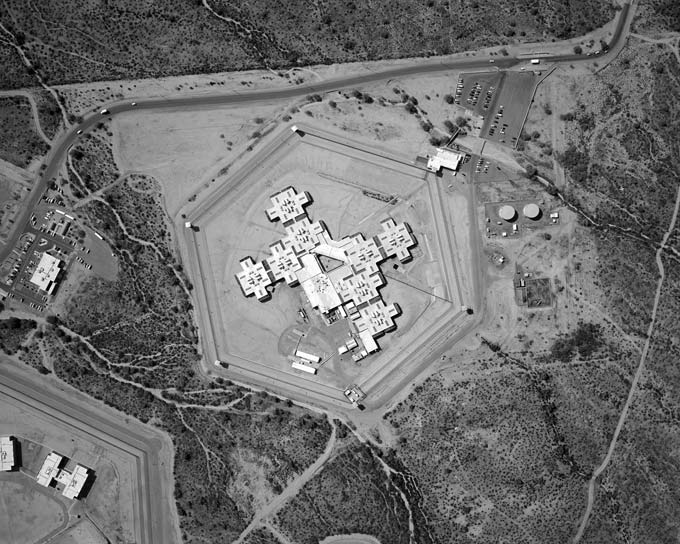
Christoph Gielen, Untitled XVIIII Arizona, 2010.
The resemblance in shape between the Ventura County section and the Florence State Prison maximum-security unit above—completely unrelated in function—is striking. This prison’s six housing units have an inmate capacity of nearly 4,000. In Supermax, Sharon Shalev cites the maximum-security tracts seen here as forerunners of today’s increasingly high-tech Supermax facilities. The Florence State Prison is also the “Central Unit” of Arizona’s death chamber, where the current method of execution is lethal injection, as it is in all 33 states where capital punishment remains legal.
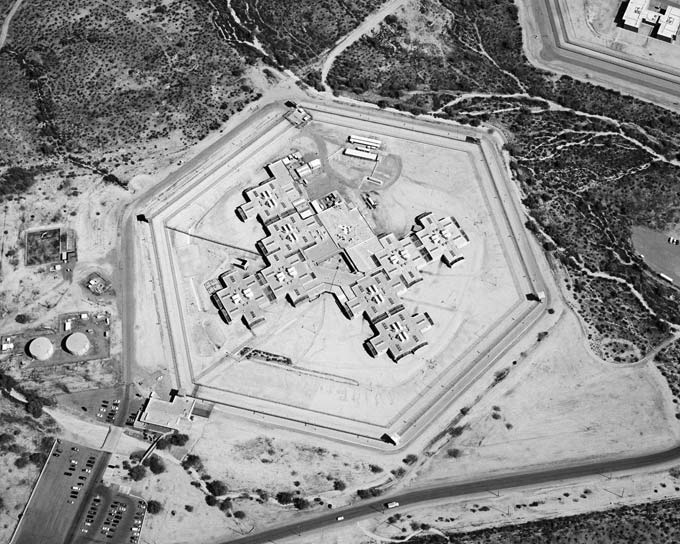
Christoph Gielen, Untitled XVII Arizona, 2010.
“American Prison Perspectives” calls attention to architectural features specifically developed to minimize prisoner movement and to produce isolation within the complex. My photographs pull into sharp focus such design details as “exercise yards” consisting of empty outdoor 8 x 10 foot enclosures attached to the back of each cell block, with bare concrete surfaces and a set of bars atop their high walls. “Exercise yard” is a misnomer; they should be called “cages.”
I counted a total of 94 such “exercise yards,” in 47 divided sets attached to the exteriors of these eight cross-shaped housing pods—all redolent of Marcia Powell’s case. They can be clearly seen in the shot below as the bright sunlight strikes this silver-roofed complex.
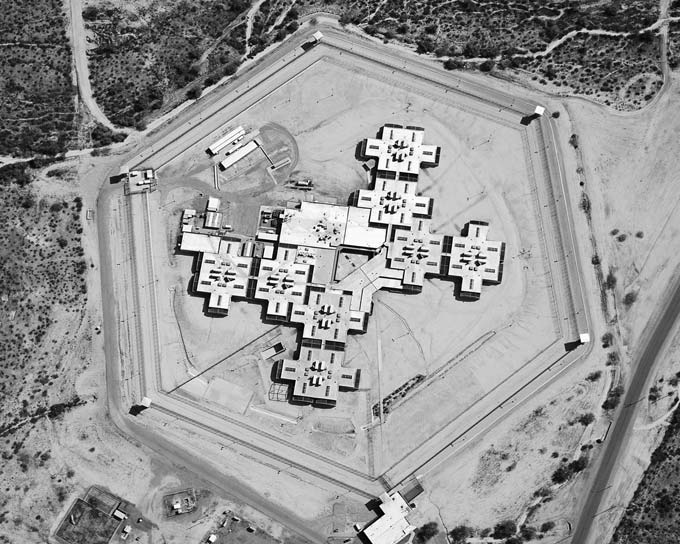
Christoph Gielen, Untitled XV Arizona, 2010.
Providing the opportunity to visually examine these restricted locations is significant; while some (typically low-resolution) satellite images of prison complexes are available in the public domain, the public cannot inspect Supermax facilities on the ground. Even journalists may be barred from entering, and almost certainly from taking photos on-site, due to new security measures in place since September 11, 2001, which often require background checks and security screening. Paradoxically, many journalists have been granted interviews with individual prisoners—as permitted by state law and at the discretion of the warden—even as their access to the prisons themselves remains scant.
I am particularly excited about recent related discussions from within the architectural sector. Specifically Canadian architect Raphael Sperry, the first architect to receive the Justice Initiative Fellow grant by Open Society Foundations, announced his campaign to amend the American Institute of Architects’ Code of Ethics and Professional Conduct to “prohibit the design of spaces intended for long-term solitary isolation and execution.”
We need to examine the culture of incarceration responsible for keeping a substantial portion of the U.S. population imprisoned.
The debate about solitary confinement is particularly relevant now because it coincides with a financial tipping point: Despite continued support by various State Departments of Corrections and interest groups, maintaining high-tech Supermax systems is becoming increasingly unsustainable. Illinois, for example, is among a growing number of economically troubled states gradually shifting away from the use of Supermax prisons. State legislators there have closed the Tamms Correctional Center, the state’s only super-maximum security prison. The true cost of keeping inmates confined in Supermax prisons, particularly in relation to state budgets and taxpayer spending, is thus in urgent need of further examination.
Beyond this, we need to examine the culture of incarceration responsible for keeping a substantial portion of the U.S. population imprisoned under what can only be deemed inhumane conditions. Current U.S. policies regarding solitary confinement are controversial not only considering definitions of torture under international law but also in light of our own Eighth Amendment, which prohibits cruel and unusual punishment. As Senator Dick Durbin urged in his June 19, 2012 appeal to the Senate Committee on the Judiciary (PDF), the stakes are high: More than 80,000 inmates are currently held in isolation in so-called Security Housing Units (SHUs), according to a 2005 Bureau of Justice Statistics census. They are locked up for as long as 23 hours a day in small single cells, without windows or direct access to natural light, and without meaningful activities of any kind.
What does our ongoing tolerance of this practice say about us as a society?
Support for this dispatch comes from The Fund for Investigative Journalism. Donate to “American Prison Perspectives” here.

